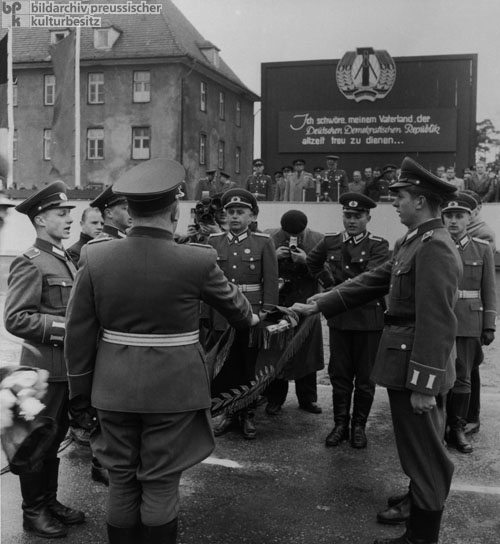













INTRODUCTION | DOCUMENTS | IMAGES | MAPS | EDITOR
|
In addition to the provisional police units set up in the Soviet occupation zone in the summer of 1945 – later officially called the German People's Police [Deutsche Volkspolizei or DVP] – the German Border Police [Deutsche Grenzpolizei or DGP] was set up as a paramilitary group in November 1946 and the DVP's Barracked Security Police was established in July 1948. Both of these bodies were created by order of the Soviet Military Administration (SMAD). After the Federal Republic signed the European Defense Community (EDC) Treaty in May 1952, thereby making a West German armed forces foreseeable, the GDR transformed its existing paramilitary units into the Barracked People's Police [Kasernierte Volkspolizei or KVP] on July 1, 1952. By the end of the year, the KVP was already 90,000 men strong. In May 1955, the Soviet Union responded to the signing and ratification of the Bonn-Paris Conventions – and the Federal Republic's resulting incorporation into NATO – by forging the Warsaw Pact with its "allies" Albania, Bulgaria, the GDR, Poland, Romania, Czechoslovakia, and Hungary. After making a few amendments to the constitution to allow for the formation of armed forces, the People's Parliament [Volkskammer] passed a law establishing the National People's Army [Nationale Volksarmee or NVA] and the Ministry of National Defense on January 18, 1956. The first unit in the new NVA was the First Mechanized Division (Potsdam), which was sworn in on April 30, 1956 (below), and officially deployed when Willy Stoph, Minister of National Defense, handed over the divisional flag. Photo by Herbert Hensky.
© Bildarchiv Preußischer Kulturbesitz / Herbert Hensky |
 print version
print version return to image list
return to image list previous image
previous image
